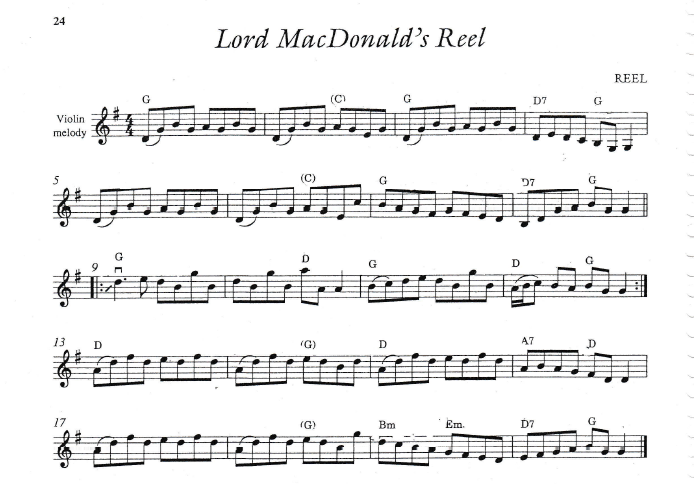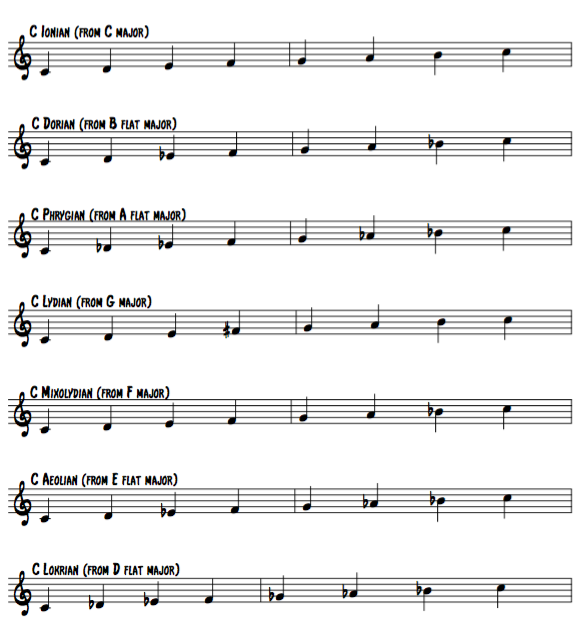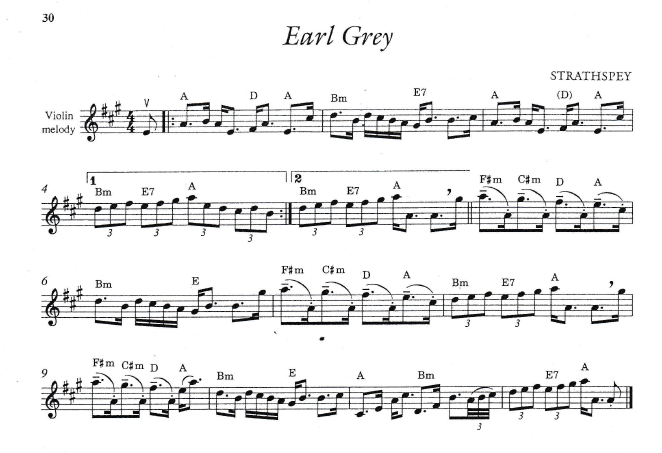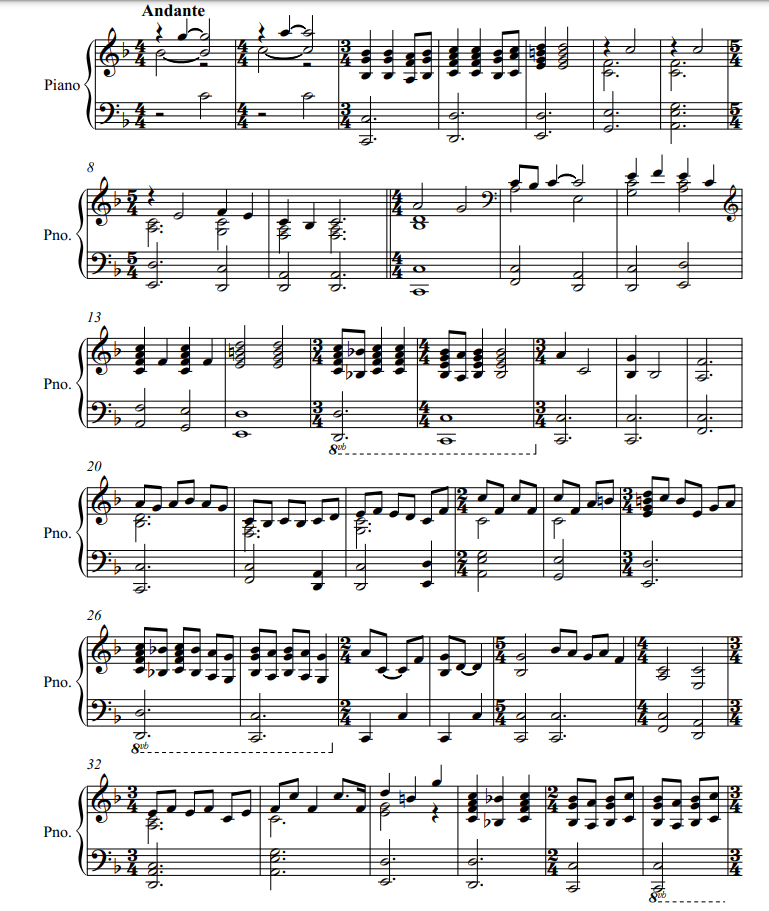reel
The first stage of trying to work out how to write a Scottish dance as one of the movements for a set of pieces for piano quintet I looked at a traditional "Reel". Below is one, showing the characteristic constant quaver movement of the form.
The next step was to come up with an original musical theme which had the features of the piece above but was my own music.
Below is my theme.
Below is my theme.
As can be seen from "Lord MacDonald's Reel" (printed above) - from bar 9 it goes into a second section, so I had to compose a second section which served the purpose it does in the traditional reel of being a distinctly new section but with similar music.
Below is a video of the second section leading back into the theme again.
Below is a video of the second section leading back into the theme again.
The original reel I am using as a starting point is in the key of G major. My theme is 'in G' but is using a modal scale.
Below are written out all the traditional modal scales (all beginning on the note C).
Below are written out all the traditional modal scales (all beginning on the note C).
The mode I used in the theme of my reel is the Mixolydian mode. This mode is characterised by it being almost exactly a major scale but with the second last note flattened. The reason I have shown the modes all starting on C is to explain as simply as possible the 'change' from the conventional major scale. If you were to play all the white notes on a piano keyboard from C up to the next C you come to it would be a C Major scale. If, instead of playing the second last white note you come to (a B on the keyboard), you played a Bb then that would be the Mixolydian scale.
[Note: in the key my theme is in (G), again you play all the notes from G to the next G. Normally you would play an F# as the second last note of the major scale but if you flatten that to an F Natural, then you have the Mixolydian scale beginning on G]
[Note: in the key my theme is in (G), again you play all the notes from G to the next G. Normally you would play an F# as the second last note of the major scale but if you flatten that to an F Natural, then you have the Mixolydian scale beginning on G]
Generating more material
If, from the outset I have set up a modal character how can I use this feature to create more musical material? Can I create a new modal scale which makes musical sense from the original theme?
Below is the Mixolydian scale on C.
EXAMPLE A
If, from the outset I have set up a modal character how can I use this feature to create more musical material? Can I create a new modal scale which makes musical sense from the original theme?
Below is the Mixolydian scale on C.
EXAMPLE A
I have used slurs to show where the semi-tones are. So the Mixolydian scale consists of: a tone, a tone, a semi-tone, a tone, a tone, a semi-tone, and a tone.
As this is the scale that forms my theme, how can I modify this scale to create a new scale which I can use to generate more material. If I read the scale backwards (i.e. its retrograde), then the descending scale would consist of: a tone, a semi-tone, a tone, a tone, a semi-tone, a tone, and a tone. Below is exactly that (each interval that ascends in the original just descending in the example below:
EXAMPLE B
As this is the scale that forms my theme, how can I modify this scale to create a new scale which I can use to generate more material. If I read the scale backwards (i.e. its retrograde), then the descending scale would consist of: a tone, a semi-tone, a tone, a tone, a semi-tone, a tone, and a tone. Below is exactly that (each interval that ascends in the original just descending in the example below:
EXAMPLE B
So, to clarify, In example A the scale moves up a tone, then a tone, then a semi-tone etc. Example B moves down by these distances ( a tone, then a tone, then a semi-tone etc). In example C, below, all I have done is put these notes into an ascending scale (on the note C), and in example C (ii) we see exactly the same scale begin on the note G (since that's the starting note I need for my composition)
EXAMPLE C
EXAMPLE C
EXAMPLE C (ii)
Now this new scale can be applied to the music I have already written to create a "variation".
Below is a video (with the score) showing how I applied this 'transformation' to the second half of my original theme.
Below is a video (with the score) showing how I applied this 'transformation' to the second half of my original theme.
Strathspey
Applying the same kind of process to another movement in the work for Piano Quintet, I looked at the Scottish Strathspey.
Below is an example of a traditional Strathspey.
Below is an example of a traditional Strathspey.
The rhythmic feature which immediately stands out is the "Scottish Snap" rhythm. I began to sketch ideas around this distinctive feature but wanted to see if I could create a more melancholy mood. Music which is reflective, rather than music to be danced to.
Below is a video of a piano piece I wrote which acts like a sketchbook of ideas for a more substantial piece.
Below is a video of a piano piece I wrote which acts like a sketchbook of ideas for a more substantial piece.
Those sketches in the video above started to generate music which is becoming the opening of the second movement. There is a lot of material from the "sketches" which didn't make it into this version below so I have lots of material to work as transitions, or for the basis for a new section (if needed) to balance out the form. The opening of the movement is in the video below.
The 'Slow Movement'
Since my Quintet is basically following "Sonata Form" I need to find a way of producing a slow movement which has a relation to Scottish traditional music. I break from my idea of this being a work made up of dance movements by having a lyrical Scottish Ballad to form my slow movement. As composers have often done with this 'singing style' (cantabile) slow movements.
The following solo piano piece takes it's phrase structure from the famous poem "Auld Lang Syne" and is basically a "song without words" for piano.
As you can see from the score below, it is a mainly chordal piece which I thought could be treated like a chorale ( a hymn-like tune harmonised in a chordal/homophonic way) as is this piano piece.
The scope for generating music for this slow movement began to form when I realised that, if this piano piece is a chorale, then the form used by composers, throughout different periods of musical history, of the "Chorale Prelude" could be the inspiration to draw on for this movement.
The Britannica Encyclopedia says of the form as it is often applied today that: "Generically, the term chorale prelude is often applied to compositions that are not genuinely associated with the chorale but that do preserve the genre’s textural characteristics."
It also describes the compositional features of the form as: "The chorale prelude retained improvisational characteristics even as a fixed compositional type. Typical examples feature the hymn tune as a cantus firmus (fixed tune), which is broken down into its constituent phrases played in long note values and preceded, accompanied, and followed by contrapuntal manipulations of their salient motifs." https://www.britannica.com/art/chorale-prelude
The Britannica Encyclopedia says of the form as it is often applied today that: "Generically, the term chorale prelude is often applied to compositions that are not genuinely associated with the chorale but that do preserve the genre’s textural characteristics."
It also describes the compositional features of the form as: "The chorale prelude retained improvisational characteristics even as a fixed compositional type. Typical examples feature the hymn tune as a cantus firmus (fixed tune), which is broken down into its constituent phrases played in long note values and preceded, accompanied, and followed by contrapuntal manipulations of their salient motifs." https://www.britannica.com/art/chorale-prelude








 RSS Feed
RSS Feed